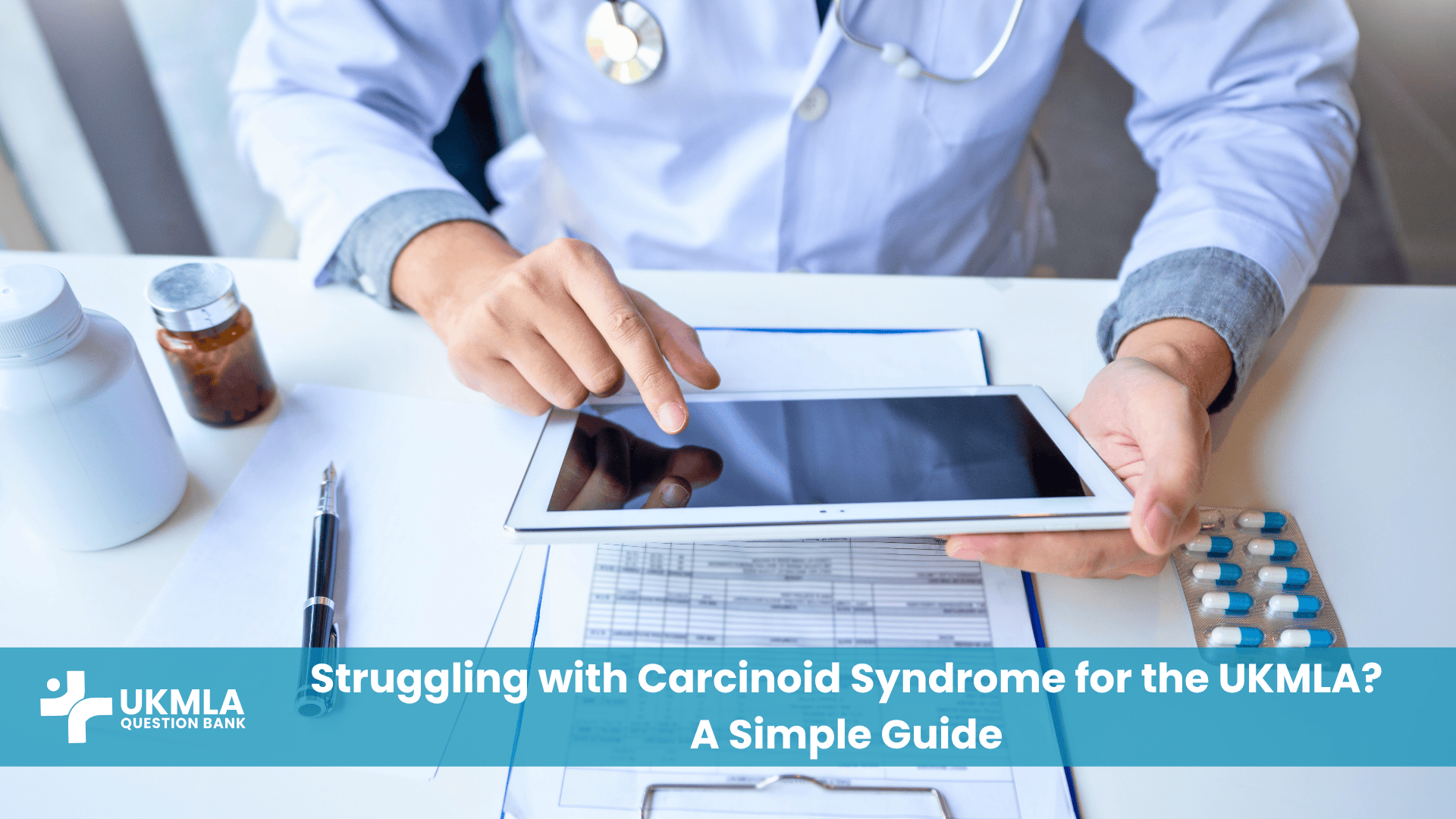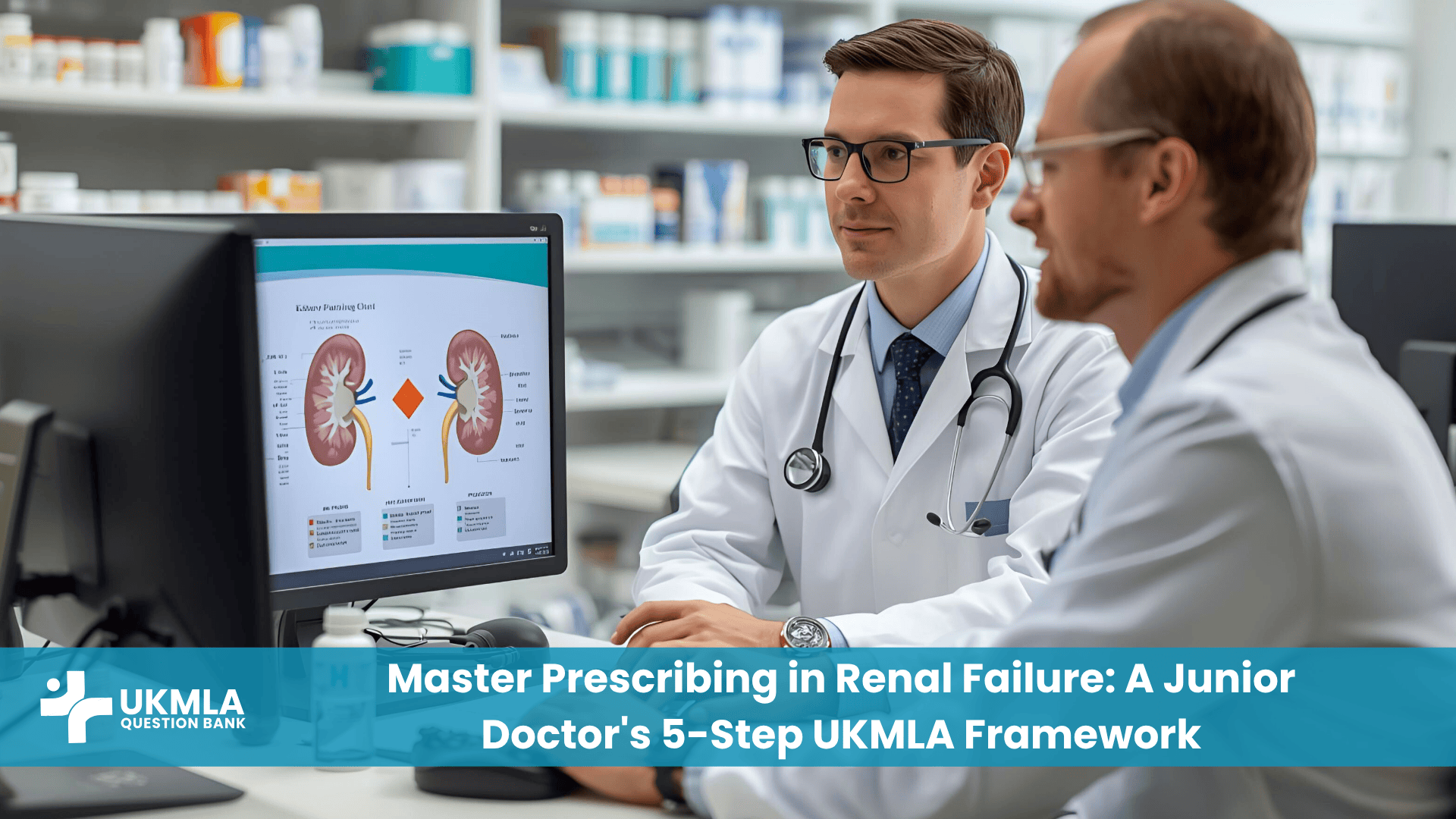Introduction
Carcinoid syndrome is a classic, high-yield topic for the UKMLA that often causes confusion due to its unique pathophysiology and presentation. If you’re struggling to connect the dots between a neuroendocrine tumour and symptoms like flushing and diarrhoea, you’re not alone. This guide will simplify the core concepts you need to master for carcinoid syndrome ukmla questions, breaking down the pathophysiology, diagnosis, and management into clear, memorable points for your exam.
Table of Contents
ToggleWhat Exactly Is Carcinoid Syndrome?
Understanding this topic starts with separating the tumour from the syndrome. They are not the same thing, and this distinction is a common exam point.
From Carcinoid Tumour to Carcinoid Syndrome (The Crucial Difference)
A carcinoid tumour is a type of neuroendocrine tumour (NET) that can arise in various parts of the body, most commonly in the gastrointestinal tract. You can find excellent background information on these tumours from sources like Cancer Research UK. These tumours can secrete vasoactive substances like serotonin, but they don’t always cause symptoms.
Carcinoid syndrome refers to the collection of symptoms that occur when these vasoactive substances enter the systemic circulation in large amounts.
Clinical Pearl: Remember, not all carcinoid tumours cause the syndrome. The syndrome typically only occurs once the tumour has metastasized to the liver. This is because the liver normally metabolizes serotonin from a gut tumour (first-pass metabolism). Once liver metastases are present, the serotonin can bypass this process and enter the systemic circulation.
The Key Player: Why Serotonin Overproduction Matters
The symptoms of carcinoid syndrome are primarily caused by the overproduction of serotonin. This hormone has widespread effects, leading to the classic triad of symptoms. This topic is a key part of the UKMLA endocrinology essentials guide.
Recognising the Classic Symptom Triad
For your AKT, being able to spot the classic triad of symptoms is crucial for identifying carcinoid syndrome in a clinical vignette.
Flushing (Episodic, often with a specific trigger)
This is the most common sign. Patients experience sudden episodes of a reddish-purple flush, typically on the face and upper chest. These episodes can be triggered by alcohol, stress, or certain foods.
Secretory Diarrhoea (Watery and persistent)
Serotonin dramatically increases gut motility, leading to secretory diarrhoea. This is often watery, frequent, and can be explosive, causing significant distress and dehydration. As the primary tumours are often in the GI tract, this is a core topic in gastroenterology for the UKMLA.
Bronchospasm (Asthma-like wheezing)
Less common than flushing and diarrhoea, bronchospasm can present as asthma-like symptoms with wheezing and shortness of breath.
The Definitive Diagnosis: Nailing the 5-HIAA Test
Once you suspect carcinoid syndrome, confirming it requires a specific biochemical test.
How the Urinary 5-HIAA Test Works
The gold standard for diagnosis is measuring the 24-hour urinary excretion of 5-hydroxyindoleacetic acid (5-HIAA). 5-HIAA is the main breakdown product (metabolite) of serotonin. Elevated levels in a 24-hour urine collection confirm excessive serotonin production, thus diagnosing the syndrome.
Common Pitfalls: Foods and Drugs that Can Cause a False Positive
A common point of confusion—and a great exam question—is knowing that certain foods and medications can interfere with the 5-HIAA test. Patients must avoid these for several days before the test.
Table 1: Common Interferences with the 5-HIAA Test
| Category | Examples |
| Serotonin-Rich Foods | Bananas, walnuts, pineapple, tomatoes, kiwi |
| Medications | Paracetamol, caffeine, L-DOPA, nicotine |
Core Management Principles for carcinoid syndrome ukmla
Management focuses on controlling the debilitating symptoms. For further reading, the Mayo Clinic provides an excellent overview.
Symptom Control with Somatostatin Analogues (Octreotide)
The mainstay of medical treatment is somatostatin analogues, such as octreotide. These drugs work by binding to somatostatin receptors on the tumour cells, which inhibits the release of serotonin and other vasoactive hormones, thereby controlling the flushing and diarrhoea.
Managing an Acute Carcinoid Crisis
A carcinoid crisis is a life-threatening event where a massive release of hormones causes profound flushing, severe bronchospasm, and hemodynamic instability (severe low or high blood pressure). It can be triggered by stress, surgery, or anaesthesia. It is managed with high-dose intravenous octreotide.
Frequently Asked Questions (FAQ) about Carcinoid Syndrome for UKMLA
The liver effectively clears the serotonin produced by the gut tumour via first-pass metabolism. The syndrome only develops when liver metastases allow the serotonin to enter the systemic circulation directly.
It’s a life-threatening, massive release of hormones, often triggered by anaesthesia, surgery, or chemotherapy. This is why patients are pre-treated with octreotide before procedures.
No. Carcinoid syndrome is the collection of symptoms. A NET is the underlying cause. Many NETs do not secrete hormones and do not cause the syndrome.
This is a fine detail but “wet” flushes (with sweating and lacrimation) are associated with foregut tumours (e.g., lung), while “dry” flushes are more common with midgut tumours (e.g., small intestine).
They mimic the natural hormone somatostatin, which acts as a universal “off-switch” for many endocrine systems. They bind to receptors on the tumour cells and inhibit the synthesis and release of serotonin.
Yes. An octreotide scan (somatostatin receptor scintigraphy) uses a radiolabeled form of octreotide that will bind to the tumour cells, allowing them to be visualized anywhere in the body.
Yes, a blood test for Chromogranin A (CgA) is a useful general tumour marker for NETs, but it is not specific to carcinoid syndrome.
A typical question would present a patient with episodic flushing and chronic diarrhoea, then ask for the single most appropriate initial diagnostic test (Answer: 24-hour urinary 5-HIAA). This makes it one of the frequently tested topics for the UKMLA AKT.
Yes, long-term exposure to high serotonin levels can cause carcinoid heart disease, leading to fibrosis of the tricuspid and pulmonary valves. This is a very high-yield complication to remember.
For the UKMLA, it is generally not necessary to know specific gene mutations for rare syndromes like this. The focus is on clinical presentation, diagnosis, and principles of management.
Conclusion
While carcinoid syndrome may seem complex, focusing on the core principles simplifies it for the UKMLA. Remember the link between liver metastases and the onset of the syndrome, memorize the classic triad of symptoms, and know that the 5-HIAA test is your diagnostic go-to. By mastering these key points, you can turn a confusing topic into an area where you can confidently score marks.




